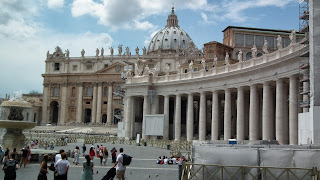The early Christian catacombs were not to be missed! I loved the Colosseum and the Forum, but the catacombs were something really special to me. You aren't allowed to take pictures in the catacombs themselves. But we did get pictures of the gardens and churches which are above the catacombs. The catacombs are a few miles outside of Rome, so we had to take a bus there. And there are several catacombs, each with miles of underground tunnels, so the entrances to each are quite far apart from one another. We decided to go to the catacomb of San Sebastian. Here we are in the gardens near the entrance to San Sebastian:

It was still mid-morning, so it wasn't too hot yet. The gardens were very peaceful and tranquil. Tim kept commenting on how peaceful it was.
Just around the corner from this sign is the church which is built directly over the catacombs. That's what the Christian church did very often: built churches on top of important sights. When we got down into the catacombs, we actually saw the remains of another church that had been the original church on top of the catacombs. The church there now was built on top of that church!
Just to the side of this church is the entrance to the catacombs. You have to have a guided tour; you aren't allowed down there by yourself. It was fascinating. The early Christian church was a very simple church, and a very tight community. The graves in which they buried their fellow Christians were simple spaces carved out of the earth. There were no statues, no commissioned artwork, no expensive possessions buried with them. There were simple carvings in the walls which symbolized Christian concepts: a carving of the dove, which symbolized peace; a carving of the anchor, which symbolized hope; a carving of the fish, ICTHYS, which is an anagram for 'Jesus Christ, God's Son, Savior' in Greek (the Greek words are Iesous Christos, Theou Yios, Soter), and the 'Chi-Rho' sign, a combination of the Greek letters X and P, which are the first two letters of Christ's name in Greek. I really got the sense that these early Christians were very humble people who had put the world behind them and placed all their hope and faith in Jesus, and in the resurrection which He made possible.
The San Sebastian catacombs are named after, of course, Saint Sebastian. Saint Sebastian was an early Christian who rose to prominence in the Roman army. The Roman emperor knew him and thought highly of him. Eventually it came out that Sebastian was a Christian, and the Roman emperor turned against him. He was put in front of a 'firing squad', so to speak, and was shot to death with arrows. I can't remember the full story, but he was a man of great courage and faith who was not afraid to stand up for Christ. They have a sort of shrine dedicated to Saint Sebastian in this catacomb.
After we saw the catacombs underground, we went into the church. There was a very interesting display there. There are a pair of bronze shoes, beneath which is the inscription 'quo vadis?' 'Quo vadis' is Latin for 'where are you going?' The story is that when Peter was about to be crucified, he tried to escape his fate by fleeing from Rome. He was on the road which led outside the city to the catacombs, and there Jesus appeared to him. When Peter saw Jesus, he asked Jesus where he was going, and Jesus answered that He was going to Rome to be crucified again. Peter then realized what he had to do, and he turned back to Rome where he would face his fate.
I don't know if that story is true, but it had quite an affect on me. I love it, because Peter asks the Lord 'where are you going?' And that's what we as Christians should be asking Jesus, because wherever Jesus is going, that's where we should be going, also. Jesus might answer that He is going to help my teenage daughter by talking to her late into the night, or He might answer that He is going visiting teaching, or to the refugee center, etc. I have to be the one to listen to where He is telling me to go.
Here is a picture of the art work on the ceiling of that church:
We got on our feet again and walked into Vatican City. It is surrounded by huge Roman pillars, with marble statues of all the saints along the top. But the impression you get is that of the Catholic church copying ancient Rome, with all it's temples and statues of pagan gods.
Then we went into St. Peter's Basilica, a breathtakingly opulent building. Tim wasn't a fan and thought it was too showy. Clearly, the place is designed to impress.
All along the top of the Basilica, there are written the words which Jesus spoke to Peter from various passages in the New Testament. Here is an excerpt from 'I say unto thee, Peter, that upon this rock I will build by church ....'
St. Peter's boasts Michaelangelo's 'Pieta', the sculpture of Mary holding Jesus after He was taken down from the cross. Michaelangelo sculpted this when he was 25. I found it to be superbly beautiful, and very moving.
Here are some other pictures from the Basilica. They speak for themselves:

















